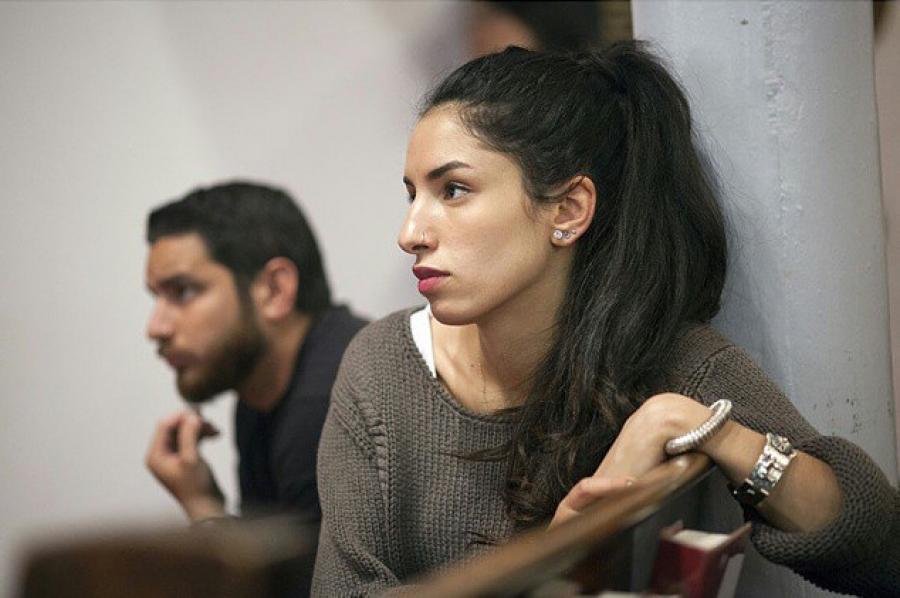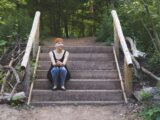Rana Nazzal chronicles life in Palestine today for the digital age. The 26 year-old artist and activist moved to Canada as a refugee from Syria in the 1990s, and reclaimed her Palestinian citizenship in 2008. She moved to the West Bank city of Ramallah in 2011, and has been going back and forth ever since. Nazzal’s social media platforms offer piercing accounts of living and resisting under occupation. In one video, she captures a photographer who was shot during May’s Great Return March and reminds her followers that commemorating 70 years of displacement comes at a price. Here, she talks about protest and reclaiming the Palestinian narrative.
https://www.instagram.com/p/BimIEB2n9C1/?utm_source=ig_embed
On Canadians’ understanding of Palestinians. Folks I’ve interacted with in Canada often have an orientalist view of Palestinians. By those who are ignorant, we’re seen as violent, irrational, or terrorists. But even by many who are sympathetic to our cause, we’re seen as agentless victims, driven to resist out of desperation, and in need of saving. The problem with this narrow view is that it erases the range of voices and identities we have here in Palestine – it demands pity rather than solidarity. Palestine is a struggle for self-determination, and that begins with hearing the voices of those who are ready to reshape the nation and support Palestinians’ right to resist.
On why Palestinians are protesting. We protest for many of reasons. Some of them are personal. Sometimes protesting is one of the only things you can do when the anger and the upset gets built up inside you. Protests are an effective part of the equation that makes up our resistance. Without them, occupying forces wouldn’t know that the people do not accept their presence here. Palestinians have been leading non-violent resistance for decades. These methods have been used since the beginning of Israeli apartheid. Some we’ve created, others we’ve adapted from non-violent movements around the world. At the moment, active resistance in the West Bank is unarmed. It is an active non-violence that takes many forms, and is at its core about disrupting – not what most people think of when they hear the words “non-violence.”
https://www.instagram.com/p/Biz3nQKH0g2/?utm_source=ig_embed
On the price of activism. For young Palestinians, organizing has been made increasingly difficult both by the Palestinian government, and the Israeli occupying force. Most organizing leaders end up in prison, which includes student leaders, and student body presidents. For instance, undercover Israeli police recently raided Birzeit University in the West Bank to arrest one of their student body members. Because of this, smaller groups and spontaneous types of resistance are taking shape instead. They serve as a beautiful testament to how people continue to organize – even under intense surveillance, threat of arrest, threat of injury, or death. They find ways, again and again, to keep fighting back.
On protesting. I always go to protests as a protester. Sometimes I’ll have my camera, other times I’ll have medical supplies, like alcohol pads, to help those who are hit by tear gas. I may even have plans to write an article afterwards. But regardless of my motives, always being there as a protester is a conscious decision I make.
On activism via social media. I started using Twitter heavily in 2011 to document what was happening at protests and actions in real time. Other young Palestinians and I built a following of people around the world who were interested in knowing what was happening on the ground. We used those networks to build Twitter storms in support of hunger striking political prisoners.
https://www.instagram.com/p/Biz_fLanmSU/?utm_source=ig_embed
On perspective. At protests, journalists (which I can be perceived as because of my camera) are often allowed to stand behind soldiers. I did this a few times years ago, but later decided I no longer wanted photos taken from soldiers’ point of view. We need to document current events in a way that truly honours the voices of those who are most affected. Although I still document events I see happening around me, these days, I try to let my social media act as a multifaceted reflection of myself and my community. It’s simple, but it’s radical, because our existence as complex human beings is so often denied.
On the power of language. Documenting things right also means changing the way we write about Palestine. We do this by making simple changes to the language we use. We don’t say “rubber bullets,” we say rubber-coated steel bullets, because that is what they are. We don’t say “clashes,” we say protests. We don’t say “the Palestinian-Israeli conflict” because it’s not a conflict. It’s a military occupation, a military siege, an apartheid system. There are plenty words we can use, but “conflict,” the word that is so often used in the media, is not the right one.
On local journalism. It’s important that we Palestinians document events in a certain way, because foreign journalists often do a lazy type of reporting. They sometimes report on events without contextualization, and fail to examine the deeper reasons behind things that are happening. May 15th’s Great Return March was interpreted by many as “people protesting the opening of the U.S. embassy in Jerusalem,” which framed the protest as having started and ended with Trump’s decision. But this simply isn’t true. Trump’s decision was one step in a very long history of ethnic cleansing that has been happening in Jerusalem. The Great Return March isn’t only looking at this event, but is a several-week long and ongoing protest that is fighting for the right of return for refugees in Gaza, around the world and here in the West Bank. The right of return that they have been denied since 1948.
https://www.instagram.com/p/Bj77K5Enef_/?utm_source=ig_embed
On sanctions. The latest protest I’ve witnessed was a historic one. On June 11, 2018, over 2,000 people took to the streets of Ramallah to demand an end to punitive sanctions on Gaza – sanctions imposed not just by Israel, but also by the Palestinian Authority (PA). The masses came out in support of our people in Gaza, but it was also among the largest protests ever to shout shame at our own government, the PA, which has maintained security coordination with Israel, and which can do very little without Israel’s approval.
On the current government. Under the PA’s rule, illegal Israeli settlements have continued to grow, the apartheid wall continues to be built, Palestinian land continues to be annexed, and freedom of movement is increasingly restricted – even our government officials need Israeli permits to leave and enter the country, and a third of our parliamentary council is currently in Israeli prison. In continuing to play in this facade of a “Palestinian government,” the PA has become complicit in crimes perpetrated by Israel and contributed to the divisions imposed on our people. Thousands chanted for unity beyond the geographic divisions, and beyond the political factions.
https://www.instagram.com/p/Bi4mGoLnyxe/?utm_source=ig_embed
On the future. The reality of the people participating in creative popular resistance is often erased and replaced by the homogenous image those following from the outside expect. If the June 11th protest is any indication, I believe many Palestinians are ready for a unified and diverse movement, by which I mean, one that represents Palestinians everywhere – in the diaspora, in the refugee camps, in the West Bank, in Gaza, and those holding Israeli citizenship and living as second class citizens. We are forming cohesive popular movements that are rising up against all obstacles to our liberation.
https://www.instagram.com/p/BjKNmpFnzmJ/?utm_source=ig_embed
On response to her work. The amazing movements of Black and Brown youth, queer and trans folks, workers, prisoners and students that I organized alongside in Canada get to follow our movements in Palestine, and a glimpse of what everyday occupation looks like. Palestinian refugees in the diaspora message me saying they’re grateful for pictures of the land and fruit trees and sunsets. Palestinians in Gaza, who documented every step of the Great Return March on social media, see us protesting in support of them and send us heartwarming messages. Sometimes I just talk about how I feel hopeless or tired. I think this makes it more real, more relatable. My social media reflects life in Palestine – we build unity and resist division, mourn, feed our anger, organize, laugh, cry, cultivate hope and learn from each other. And we find ways, again and again, to keep fighting back.
Interview has been edited and condensed for clarity.















